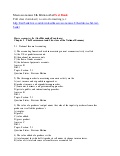

Why is the demand for a luxury generally more elastic (or less inelastic) than the demand for a necessity? Demand for a necessity is generally less elastic than demand for a luxury because there are fewer substitutes for a necessity. Usually, the more time that has passed after a price change, the greater is the price elasticity of demand for a good. The larger the portion of the consumer’s budget being spent on a good, the greater is the price elasticity of demand for that good. The proportion of income spent on the good. The more easily people can substitute other items for a particular good, the larger is the price elasticity of demand for that good. What makes the demand for some goods elastic and the demand for other goods inelastic? The magnitude of the price elasticity of demand for a good depends on three main influences: Closeness of substitutes.

The percentage change in quantity (price) is measured as the change in quantity (price) divided by the average quantity (price). It equals the absolute value (or magnitude) of the ratio of the percentage change in the quantity demanded to the percentage change in the price. The price elasticity of demand is units-free measure of the responsiveness of the quantity demanded of a good to a change in its price when all other influences on buying plans remain the same. The elasticities of different goods also can be compared even though they are measured in different units.ĭefine the price elasticity of demand and show how it is calculated. As a result, the elasticity can be compared across the same good when quantity is measured in different units and/or the price is measured in different currencies. The value of the elasticity is independent of the units used to measure the price and quantity of the product. The slope of the demand curve changes as the units measuring the same quantity of the good change (going from pounds to ounces, for example). Compare it as a measure of the responsiveness to some other candidate that depends on the units, such as the slope. Why do we need a units-free measure of the responsiveness of the quantity demanded of a good or service to a change in its price? The elasticity of demand is a units-free measure.


 0 kommentar(er)
0 kommentar(er)
